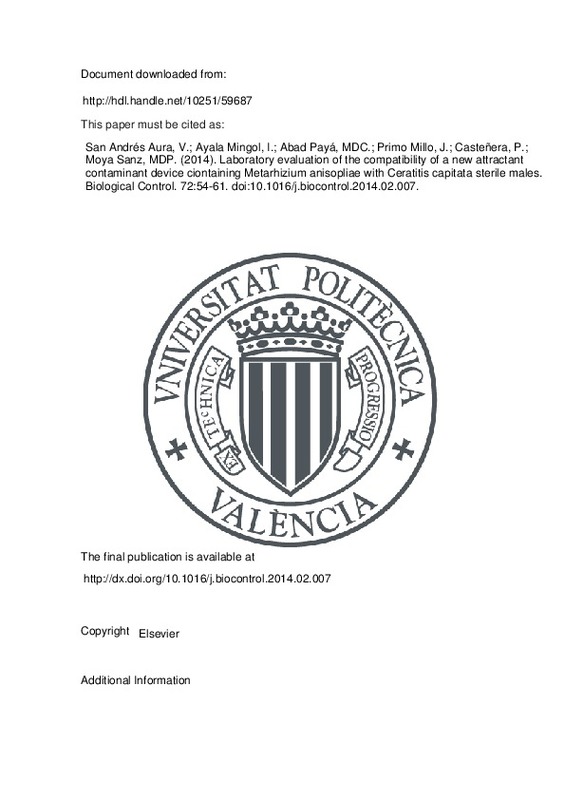JavaScript is disabled for your browser. Some features of this site may not work without it.
Buscar en RiuNet
Listar
Mi cuenta
Estadísticas
Ayuda RiuNet
Admin. UPV
Laboratory evaluation of the compatibility of a new attractant contaminant device ciontaining Metarhizium anisopliae with Ceratitis capitata sterile males
Mostrar el registro sencillo del ítem
Ficheros en el ítem
| dc.contributor.author | San Andrés Aura, Victoria
|
es_ES |
| dc.contributor.author | Ayala Mingol, Ildefonso
|
es_ES |
| dc.contributor.author | Abad Payá, María del Carmen
|
es_ES |
| dc.contributor.author | Primo Millo, Jaime
|
es_ES |
| dc.contributor.author | Casteñera, P.
|
es_ES |
| dc.contributor.author | Moya Sanz, Mª del Pilar
|
es_ES |
| dc.date.accessioned | 2016-01-12T08:02:22Z | |
| dc.date.available | 2016-01-12T08:02:22Z | |
| dc.date.issued | 2014-05 | |
| dc.identifier.issn | 1049-9644 | |
| dc.identifier.uri | http://hdl.handle.net/10251/59687 | |
| dc.description.abstract | [EN] Laboratory experiments were conducted to evaluate the compatibility of using the entomopathogenic fungus Metarhizium anisopliae, to be dispensed in a new attractant contaminant device (ACD), jointly with sterilized Ceratitis capitata males, as an integrated approach to control this major pest. The exposure of sterile Vienna 8 (V8) strain and wild type (WT) males to the contaminating part (infective dish) of the ACD showed similar susceptibility levels to the fungal strain (LT50 value of 4.52 and 4.72 days, respectively). Sterile V8 males were significantly less attracted to the infective dish (18.4%) than WT males (28.5%). As the success of Sterile Insect Technique (SIT) heavily relies on the mating success of sterile males in the field, mating performance of infected males was assessed. Around 85% of the females were mated, independently of the male strain and treatment (fungus-treated or untreated males) indicating that mating performance was unaffected by the fungus under laboratory conditions. Females showed a greater tendency to remate if previously mated to fungus-treated males, either V8 or WT. Our data suggest that this M. anisopliae based-ACD does not impair the performance of C. capitata sterile males and, therefore, it could be used combined with area wide SIT-based programs, providing that these results are validated in field conditions. The implications of this combined strategy to control C. capitata are discussed. (C) 2014 Elsevier Inc. All rights reserved. | es_ES |
| dc.description.sponsorship | This work was partially supported by the "Comision Interministerial de Ciencia y Tecnologia" (CICYT, Spain) (Grant: AGL2006-13346-C02-02). | |
| dc.language | Inglés | es_ES |
| dc.publisher | Elsevier | es_ES |
| dc.relation.ispartof | Biological Control | es_ES |
| dc.rights | Reserva de todos los derechos | es_ES |
| dc.subject | Integrated control | es_ES |
| dc.subject | Entomopathogenic fungus | es_ES |
| dc.subject | Mating behavious | es_ES |
| dc.subject | Medfly | es_ES |
| dc.subject | Tephritidae. | es_ES |
| dc.subject.classification | QUIMICA ORGANICA | es_ES |
| dc.title | Laboratory evaluation of the compatibility of a new attractant contaminant device ciontaining Metarhizium anisopliae with Ceratitis capitata sterile males | es_ES |
| dc.type | Artículo | es_ES |
| dc.identifier.doi | 10.1016/j.biocontrol.2014.02.007 | |
| dc.relation.projectID | info:eu-repo/grantAgreement/MEC//AGL2006-13346-C02-02/ES/CONTROL DE CERATITIS CAPITATA EN CITRICOS. DESARROLLO DE NUEVOS METODOS/ | es_ES |
| dc.rights.accessRights | Abierto | es_ES |
| dc.contributor.affiliation | Universitat Politècnica de València. Instituto Agroforestal Mediterráneo - Institut Agroforestal Mediterrani | es_ES |
| dc.contributor.affiliation | Universitat Politècnica de València. Departamento de Química - Departament de Química | es_ES |
| dc.description.bibliographicCitation | San Andrés Aura, V.; Ayala Mingol, I.; Abad Payá, MDC.; Primo Millo, J.; Casteñera, P.; Moya Sanz, MDP. (2014). Laboratory evaluation of the compatibility of a new attractant contaminant device ciontaining Metarhizium anisopliae with Ceratitis capitata sterile males. Biological Control. 72:54-61. https://doi.org/10.1016/j.biocontrol.2014.02.007 | es_ES |
| dc.description.accrualMethod | S | es_ES |
| dc.relation.publisherversion | http://dx.doi.org/10.1016/j.biocontrol.2014.02.007 | es_ES |
| dc.description.upvformatpinicio | 54 | es_ES |
| dc.description.upvformatpfin | 61 | es_ES |
| dc.type.version | info:eu-repo/semantics/publishedVersion | es_ES |
| dc.description.volume | 72 | es_ES |
| dc.relation.senia | 290153 | es_ES |
| dc.contributor.funder | Ministerio de Educación y Ciencia |







![[Cerrado]](/themes/UPV/images/candado.png)

